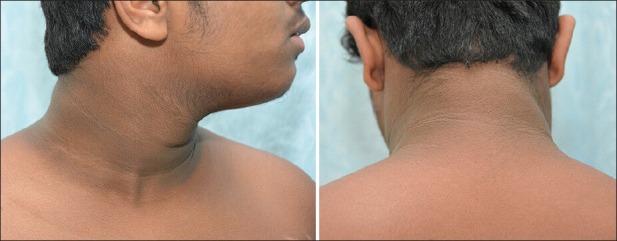Sir
Read with interest the article, atypical presentation of acanthosis nigricans.[1] Acanthosis nigricans (AN), a marker of insulin resistance is common in type 2 diabetes, polycystic ovarian syndrome, and obesity. AN can also be a manifestation of internal malignancies.
We recently came across acanthosis nigricans in a 14-year-old boy with insulinoma. He had AN at neck [Figure 1] and axilla. He presented with history of unconsciousness with fasting hypoglycemia for 2 years which was initially once in 2 months but gradually over 2 years increased to once every 2-3 hours. He also developed siezures for which he was started on anti-epileptics. There was no family history of diabetes. Father and grandfather were obese. He had a weight gain of 37 kgs over 2 years. At presentation to us, he had a height of 157 cm, a weight of 71 kgs, and a body mass index (BMI) of 29 kg/m2. His HbA1c was 5.1, serum cholesterol 243 mg/dl, low-density lipoprotein (LDL) 170 mg/dl, triglycerides 258 mg/dl VLDL 51 mg/dl. During spontaneous hypoglycemia with a plasma glucose of 37 mg/dl with simultaneous insulin of 133.5 microU/ml (normal 2.6 to 24.9 microU/ml) and C peptide of 12.14 (normal 1.1 to 4.4 ng/ml). There was a 1.4 × 1.2 cm lesion seen in the head of pancreas on magnetic resonance imaging (MRI) and endoscopic ultrasound. His insulin like growth factor 1(IGF 1) 1 was 207 ng/ml (normal range for his age 188 to 509 ng/ml), basal GH was 0.01 ng/ml, post 75 grams glucose was 0.14 ng/ml at 1 hour, and 0.1 ng/ml at 2 hours. Serum prolactin and intact PTH were normal.
Figure 1.

Acanthosis nigricans in a boy with insulinoma
He underwent enucleation of the insulinoma. Post-operatively his hypoglycemia disappeared but blood sugar charting premeals were in the range of 110-134 mg/dl. A 1.8 × 1.1 cm tumor was enucleated which on histology was synaptophysin and chromogranin positive. Insulin stain was positive with a MIB index less than 2%. This confirmed a grade 1 neuroendocrine tumor- insulinoma.
In our series of 31 patients of insulinoma,[2] we have not find (AN) in any patient. There have been case reports of AN in insulinoma which has been found to improve post operatively.[3,4] Excess insulin binds to IGF-1 receptors on fibroblasts and keratinocytes causing proliferation of epidermis leading to acanthosis nigricans.[3] In that case resolution of the acanthosis post surgical resection of insulinoma, even before weight loss sheds light on the pathogenesis of AN being hyperinsulinaemia. Another case of disappearance of AN following partial pancreatectomy in HAIR-AN syndrome has been reported.[4]
Why AN is present in some patients of insulinoma and not in others and whether it correlates to the level of serum insulin and weight gain needs to be investigated. In our patient, insulin levels were very high and weight gain was significant. His lipid profile was also altered.
REFERENCES
- 1.Roy N, Das T, Kundu AK, Malty A. Atypical presentation of acanthosis nigricans. Indian J Endocrinol Metab. 2012;16:1058–9. doi: 10.4103/2230-8210.103048. [DOI] [PMC free article] [PubMed] [Google Scholar]
- 2.Jyotsna VP, Rangel N, Pal S, Seith A, Sahni P, Ammini AC. Insulinoma: Diagnosis and surgical treatment. Retrospective analysis of 31 cases. Indian J Gastroenterol. 2006;25:244–7. [PubMed] [Google Scholar]
- 3.Ghosh S, Roychaudhury B, Mukhopadhyay S, Chowdhury S. Clearance of acanthosis nigricans associated with insulinoma following surgical resection. QMJ. 2008;101:899–900. doi: 10.1093/qjmed/hcn098. [DOI] [PubMed] [Google Scholar]
- 4.Pfeifer SL, Wilson RM, Gawkrodger DJ. Clearance of acanthosis nigricans associated with the HAIR-AN syndrome after partial pancreatectomy: An 11 year follow-up. Postgrad Med J. 1999;75:421–2. doi: 10.1136/pgmj.75.885.421. [DOI] [PMC free article] [PubMed] [Google Scholar]


